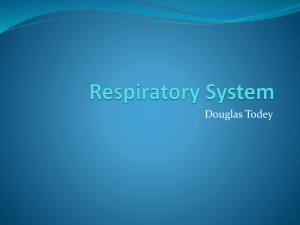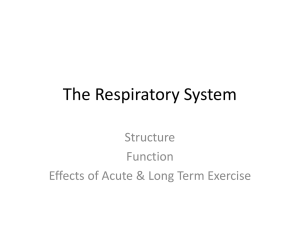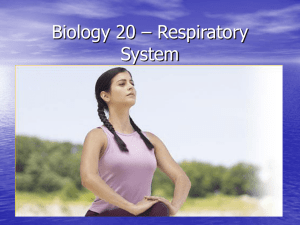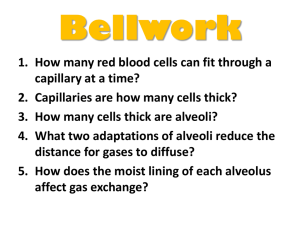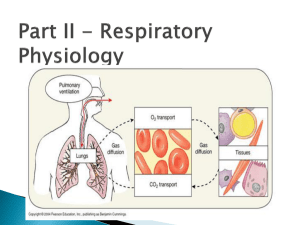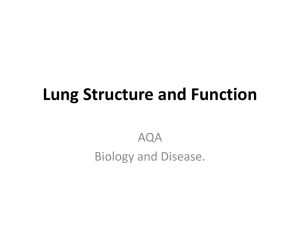Lecture: Physiology of Respiration
advertisement
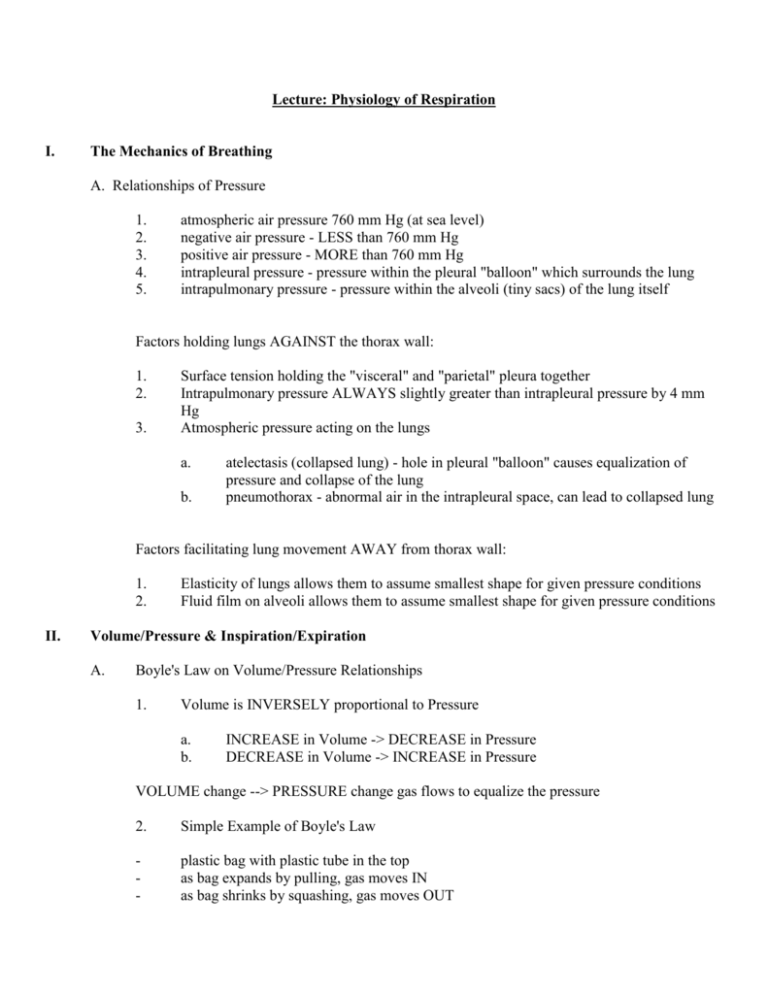
Lecture: Physiology of Respiration I. The Mechanics of Breathing A. Relationships of Pressure 1. 2. 3. 4. 5. atmospheric air pressure 760 mm Hg (at sea level) negative air pressure - LESS than 760 mm Hg positive air pressure - MORE than 760 mm Hg intrapleural pressure - pressure within the pleural "balloon" which surrounds the lung intrapulmonary pressure - pressure within the alveoli (tiny sacs) of the lung itself Factors holding lungs AGAINST the thorax wall: 1. 2. 3. Surface tension holding the "visceral" and "parietal" pleura together Intrapulmonary pressure ALWAYS slightly greater than intrapleural pressure by 4 mm Hg Atmospheric pressure acting on the lungs a. b. atelectasis (collapsed lung) - hole in pleural "balloon" causes equalization of pressure and collapse of the lung pneumothorax - abnormal air in the intrapleural space, can lead to collapsed lung Factors facilitating lung movement AWAY from thorax wall: 1. 2. II. Elasticity of lungs allows them to assume smallest shape for given pressure conditions Fluid film on alveoli allows them to assume smallest shape for given pressure conditions Volume/Pressure & Inspiration/Expiration A. Boyle's Law on Volume/Pressure Relationships 1. Volume is INVERSELY proportional to Pressure a. b. INCREASE in Volume -> DECREASE in Pressure DECREASE in Volume -> INCREASE in Pressure VOLUME change --> PRESSURE change gas flows to equalize the pressure 2. Simple Example of Boyle's Law - plastic bag with plastic tube in the top as bag expands by pulling, gas moves IN as bag shrinks by squashing, gas moves OUT B. C. III. Inspiration 1. diaphragm muscle contracts, increasing thoracic cavity size in the superior-inferior dimension 2. external intercostal muscles contract, expanding lateral & anterior-posterior dimension 3. INCREASED volume (about 0.5 liter) DECREASED pulmonary pressure (-1 mm Hg) air rushes into lungs to fill alveoli 4. * deep/forced inspirations - as during exercise and pulmonary disease scalenes, sternocleidomastoid, pectorals are used for more volume expansion of thorax Expiration 1. quiet expiration (exhalation) - simple elasticity of the lungs DECREASES volume INCREASED pulmonary pressure -> movement of air out of the lungs 2. forced expiration - contraction of abdominal wall muscles (i.e. obliques & transversus abdominus) further DECREASES volume beyond relaxed point ----> further INCREASE in pulmonary pressure ---> more air moves out Factors Influencing Pulmonary Ventilation A. Respiratory Passageway Resistance 1. upper respiratory passageways - relatively large, very little resistance to airflow (unless obstruction such as from food lodging or cancer) 2. lower respiratory passageways - from medium-sized bronchioles on down, can alter diameter based on autonomic stimulation a. b. parasympathetic - causes bronchioconstriction sympathetic - inhibits bronchioconstriction epinephrine - used to treat life-threatening bronchioconstriction such as during asthma and anaphylactic shock (carried by people susceptible to sudden constriction) B. Lung Compliance & Elasticity 1. lung compliance - the ease with which lungs can be expanded by muscle contraction of thorax a. b. c. d. fibrosis - decreases compliance blocked bronchi - decreases compliance surface tension - alveoli difficult to expand thorax inflexibility - decreases compliance 2. lung elasticity - the ease with which lungs can contract to their normal resting size (exhalation) a. emphysema - decreases elasticity 3. alveolar surface tension - liquid on surface of alveoli causes them to collapse to smallest size a. surfactant - lipoproteins that reduces surface tension on alveoli, allowing them to expand more easily infant respiratory distress syndrome - premature babies that do not yet produce enough surfactant; must be ventilated for respiration b. IV. Volumes, Capacities, and Function Tests A. Respiratory VOLUMES (20 yr old healthy male, 155 lbs.) 1. 2. 3. 4. B. Respiratory CAPACITIES 1. 2. 3. 4. D. inspiratory capacity (IC) = TV + IRV (MAXIMUM volume of air that can be inhaled) functional residual capacity (FRC) ERV + RV (all non-tidal volume expiration) vital capacity (VC) = TV + IRV + ERV (TOTAL volume of air that can be moved) total lung capacity (TLC) = TV + IRV + ERV + RV (the SUM of all volumes; about 6.0 L) Dead Space 1. 2. 3. E. tidal volume (TV) - normal volume moving in/out (0.5 L) inspiratory reserve volume (IRV) - volume inhaled AFTER normal tidal volume when asked to take deepest possible breath (2.1-3.2 L) expiratory reserve volume (ERV) - volume exhaled AFTER normal tidal volume when asked to force out all air possible (1.- 2.0 L) residual volume (RV) - air that remains in lungs even after totally forced exhalation (1.2 L) anatomical dead space - all areas where gas exchange does not occur (all but alveoli) alveolar dead space - non-functional alveoli total dead space - anatomical + alveolar Pulmonary Function Tests 1. spirometer - measures volume changes during breathing a. b. 2. obstructive pulmonary disease - increased resistance to air flow (bronchitis or asthma) restrictive disorders - decrease in Total Lung Capacity (TB or polio) minute respiratory volume (MRV) - total volume flowing in & out in 1 minute (resting rate = 6 L per minute) F. 3. forced vital capacity (FVC) - total volume exhaled after forceful exhalation of a deep breath 4. forced expiratory volume (FEV) - FEV volume measured in 1 second intervals (FEV1...) Alveolar Retention Rate (AVR) AVR (NORMAL) AVR (NORMAL) AVR V. = breath rate X = 12/minute X = 4.2 L/min (TV - dead space) (500 ml – 150 ml) Basic Properties of Gases A. Dalton's Law of Partial Pressures 1. partial pressure - the "part" of the total air pressure caused by one component of a gas Gas ALL AIR Nitrogen Oxygen Carbon Dioxide 2. 3. B. Partial Pressure (P) 760 mm Hg 597 mm Hg (0.79 X 760) l59 mm Hg (0.21 X 760) 0.3 mm Hg (0.0004 X 760) altitude - air pressure @ 10,000 ft = 563 mm Hg scuba diving - air pressure @ 100 ft = 3000 mm Hg Henry's Law of Gas Diffusion into Liquid 1. Henry's Law - a certain gas will diffuse INTO or OUT OF a liquid down its concentration gradient in proportion to its partial pressure 2. solubility - the ease with which a certain gas will "dissolve" into a liquid (like blood plasma) HIGHest solubility in plasma LOWest solubility in plasma C. Percent 100.0% 78.6% 20.9% 0.04% Carbon Dioxide Oxygen Nitrogen Hyperbaric (Above normal pressure) Conditions 1. Creates HIGH gradient for gas entry into the body 2. therapeutic - oxygen forced into blood during: carbon monoxide poisoning, circulatory shock, asphyxiation, gangrene, tetanus, etc. 3. harmful - SCUBA divers may suffer the "bends" when they rise too quickly and Nitrogen gas "comes out of solution" and forms bubbles in the blood VI. Gas Exchange: Lungs, Blood, Tissues A. External Respiration (Air & Lungs) 1. Partial Pressure Gradients & Solubilities a. b. Oxygen: alveolar (104 mm) ---> blood (40 mm) Carbon Dioxide: blood (45 mm) ----> alveolar (40 mm) (carbon dioxide much more soluble than oxygen) 2. Alveolar Membrane Thickness (0.5-1.0 micron) a. b. 3. Total Alveolar Surface Area for Exchange a. b. 4. low Oxygen in alveolus -> vasoconstriction high Oxygen in alveolus -> vasodilation high Carb Diox in alveolus -> dilate bronchioles low Carb Diox in alveolus -> constrict bronchioles Internal Respiration (Blood & Tissues) 1. 2. VII. total surface area healthy lung = 145 sq. Meters emphysema - decreases total alveolar surface area Ventilation-Blood Flow Coupling a. b. c. d. B. very easy for gas to diffuse across alveoli edema - increases thickness, decreases diffusion Oxygen: blood (104 mm) -> tissues (40 mm) Carbon Dioxide: tissues (>45 mm) -> blood (40 mm) Oxygen Transport in Blood: Hemoglobin A. Association & Dissociation of Oxygen + Hemoglobin 1. 2. oxyhemoglobin (HbO2) - oxygen molecule bound deoxyhemoglobin (HHb) - oxygen unbound H-Hb + 3. 4. O2 <= === => HbO2 + H+ binding gets more efficient as each O2 binds release gets easier as each O2 is released 5. Several factors regulate AFFINITY of O2 a. b. c. d. B. Partial Pressure of O2 temperature blood pH (acidity) concentration of “diphosphoglycerate” (DPG) Effects of Partial Pressure of O2 1. oxygen-hemoglobin dissociation curve a. b. c. d. C. Effects of Temperature 1. 2. D. --> Decreased Affinity (right) --> Increased Affinity (left) HIGHER pH --> Increased Affinity (left) LOWER pH --> Decreased Affinity (right) "Bohr Effect" a. more Carbon Dioxide, lower pH (more H+), more O2 release Effects of Diphosphoglycerate (DPG) 1. 2. 3. F. HIGHER Temperature LOWER Temperature Effects of pH (Acidity) 1. 2. E. 104 mm (lungs) - 100% saturation (20 ml/100 ml) 40 mm (tissues) - 75% saturation (15 ml/100 ml) right shift - Decreased Affinity, more O2 unloaded left shift- Increased Affinity, less O2 unloaded DPG - produced by anaerobic processes in RBCs HIGHER DPG > Decreased Affinity (right) thyroxine, testosterone, epinephrine, NE - increase RBC metabolism and DPG production, cause RIGHT shift Oxygen Transport Problems 1. hypoxia - below normal delivery of Oxygen a. b. c. 2. anemic hypoxia - low RBC or hemoglobin stagnant hypoxia - impaired/blocked blood flow hypoxemic hypoxia - poor lung gas exchange carbon monoxide poisoning - CO has greater Affinity than Oxygen or Carbon Dioxide VIII. Transport of Carbon Dioxide A. Dissolved in Blood Plasma (7-10%) B. Bound to Hemoglobin (20-30%) 1. carbaminohemoglobin - Carb Diox binds to an amino acid on the polypeptide chains 2. Haldane Effect - the less oxygenated blood is, the more Carb Diox it can carry a. b. C. tissues - as Ox is unloaded, affinity for Carb Diox increases lungs - as Ox is loaded, affinity for Carb Diox decreases, allowing it to be released Bicarbonate Ion Form in Plasma (60-70%) 1. Carbon Dioxide combines with water to form Bicarbonate CO2 + H2O <==> H2CO3 <==> H+ + HCO32. carbonic anhydrase - enzyme in RBCs that catalyzes this reaction in both directions a. b. 3. Bohr Effect - formation of Bicarbonate (through Carbonic Acid) leads to LOWER pH (H+ increase), and more unloading of Ox to tissues a. 4. D. since hemoglobin "buffers" to H+, the actual pH of blood does not change much Chloride Shift - chloride ions move in opposite direction of the entering/leaving Bicarbonate, to prevent osmotic problems with RBCs Carbon Dioxide Effects on Blood pH 1. carbonic acid-bicarbonate buffer system low pH high pH 2. 3. IX. tissues - catalyzes formation of Bicarbonate lungs - catalyzes formation of Carb Diox --> HCO3- binds to H+ --> H2CO3 releases H+ low shallow breaths rapid deep breaths --> HIGH Carb Diox --> LOW pH (higher H+) --> LOW Carb Diox --> HIGH pH (lower H+) Neural Substrates of Breathing A. Medulla Respiratory Centers Inspiratory Center (Dorsal Resp Group - rhythmic breathing) ----> phrenic nerve ----> intercostal nerves ----> diaphragm + external intercostals Expiratory Center (Ventral Resp Group - forced expiration) ----> phrenic nerve ----> intercostal nerves ----> internal intercostals + abdominals (expiration) 1. 2. B. Pons Respiratory Centers 1. 2. C. pneumotaxic center - slightly inhibits medulla, causes shorter, shallower, quicker breaths apneustic center - stimulates the medulla, causes longer, deeper, slower breaths Control of Breathing Rate & Depth 1. 2. 3. X. eupnea - normal resting breath rate (12/minute) drug overdose - causes suppression of Inspiratory Center breathing rate - stimulation/inhibition of medulla breathing depth - activation of inspiration muscles Hering-Breuer Reflex - stretch of visceral pleura that lungs have expanded (vagal nerve) D. Hypothalamic Control - emotion + pain to the medulla E. Cortex Controls (Voluntary Breathing) - can override medulla as during singing and talking Chemical Controls of Respiration A. Chemoreceptors (CO2, O2, H+) 1. 2. B. central chemoreceptors - located in the medulla peripheral chemoreceptors - large vessels of neck Carbon Dioxide Effects 1. a powerful chemical regulator of breathing by increasing H+ (lowering pH) a. hypercapnia Carbon Dioxide increases -> Carbonic Acid increases -> pH of CSF decreases (higher H+)> DEPTH & RATE increase (hyperventilation) b. hypocapnia - abnormally low Carbon Dioxide levels which can be produced by excessive hyperventilation; breathing into paper bag increases blood Carbon Dioxide levels C. Oxygen Effects 1. aortic and carotid bodies - oxygen chemoreceptors 2. 3. 4. D. pH Effects (H+ ion) 1. E. XI. slight Ox decrease - modulate Carb Diox receptors large Ox decrease - stimulate increase ventilation hypoxic drive - chronic elevation of Carb Diox (due to disease) causes Oxygen levels to have greater effect on regulation of breathing acidosis - acid buildup (H+) in blood, leads to increased RATE and DEPTH (lactic acid) Overview of Chemical Effects Chemical Breathing Effect increased Carbon Dioxide (more H+) decreased Carbon Dioxide (less H+) increase decrease slight decrease in Oxygen large decrease in Oxygen effect CO2 system increase ventilation decreased pH (more H+) increased pH (less H+) increase decrease Exercise and Altitude Effects A. Exercise Effects 1. hyperpnea - increase in DEPTH, not rate 2. steady state - increase in RATE and DEPTH gradually altered to MATCH gas exchange needs a. b. c. B. Altitude Effects 1. XII. conscious awareness of exercise cortex stimulates muscles & respiratory center proprioceptors in muscles, tendons, joints acclimatization - physiological adaptation to lower Oxygen content at higher altitude a. body “set-points” for Oxygen and Carb Diox will reset over a period of time COPD and Cancer A. Chronic Obstructive Pulmonary Disease (COPD) 1. Common features of COPD a. b. c. d. 2. obstructive emphysema - usually results from smoking a. b. c. 3. B. almost all have smoking history dyspnea - chronic "gasping" for air frequent coughing and infections often leads to respiratory failure enlargement & deterioration of alveoli loss of elasticity of the lungs "barrel chest" from bronchiole opening during inhalation & constriction during exhalation chronic bronchitis - mucus/inflammation of mucosa Lung Cancer 1. 2. 3. 4. squamous cell carcinoma (20-40%) - epithelium of the bronchi and bronchioles adenocarcinoma (25-35%) - cells of bronchiole glands and cells of the alveoli small cell carcinoma (10-20%) - special lymphocyte-like cells of the bronchi 90% of all lung cancers are in people who smoke or have smoked
